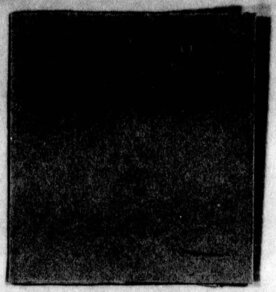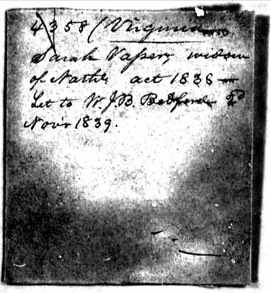Comparing a Pension File on Fold3 and Ancestry
Sometimes when a record set or image is hard to read on one genealogy website, I look for it on a different website hoping their version is better. So when I suspected a pension file was incomplete on Fold3, I examined the same file on Ancestry and was surprised at how different the images were.1
When books are captured, either digitally or on microfilm, sometimes a single image captures both the left and right sides of the open book and sometimes the left page and right page are captured individually.
The image below is from a Revolutionary War pension file found on www.fold3.com. From the image, it looks like it is the right side of a two-page booklet or letter of some kind. The left side, however, was neither immediately before nor after this image.
The bottom left of the image has a bracket, “}”, annotated with a red oval.
Using that bracket as my reference point, I looked at each image to see if this “missing” page was in the file, but somehow in a different location. The missing page was nowhere to be found.
I remembered seeing the pension file on www.ancestry.com when I was looking for other records. I decided to look to see if the images on www.ancestry.com were from the same filming as those on www.fold3.com.
What I noticed was both surprising and confusing. The images definitely came from the same filming. The pages were laid out at exactly the same angle. Both sources list the same film number from the National Archives. However, there were several differences, as outlined below.
- Ancestry had thirty-three images, two more than found on Fold3. The additional two images included one sheet of paper with the words “Selected Records” and another sheet that said “Nonselected Records”. Both sheets had a banner at the top and bottom that said “National Archives Microfilm Publications.”
- The missing left side of the www.fold3.com image discussed above is included in the www.ancestry.com copy, as shown below.
- The last major difference I noticed was that the images on Ancestry.com were lighter. One image on Fold3 looked like a black folded item. On Ancestry.com, not only was it clear that it was paper, but writing was visible.
 |
 |
| Fold3 image | Ancestry image |
I am not an expert on microfilm or why things are the way they are. But I suspect the microfilm used for the Fold3 website may have been a copy of a copy of the original National Archives Film, which would explain the poor quality. As for why one image was cropped, that is a mystery. Perhaps they were trying to make each page its own image but they forgot to include the other page.
But the moral of the story is if one genealogy website has poor image quality, look at other websites. You may find the same document in either a different filming/digitizing project or you may find a better copy of the same image, as in the pension record example described above.
-
My client gave me permission to use research I conducted for their project in this post. The pension file referenced in this blog is found at both Ancestry and Fold3 (both websites are owned by Ancestry.com).
Revolutionary War Pension File, Sarah Vasser Pensioner, Nathaniel Vasser Soldier; database with images, “U.S., Revolutionary War Pension and Bounty-Land Warrant Application Files, 1800-1900,” Ancestry.com (www.ancestry.com: accessed 4 Nov 2022); citing NARA RG 15, M804 Revolutionary War Pension and Bounty-Land Warrant Application Files, roll 2454, Washington, D.C.
Revolutionary War Pension File, Sarah Vasser Pensioner, Nathaniel Vasser Soldier; database with images, Ancestry.com (www.fold3.com: accessed 4 Nov 2022); citing NARA RG 15, M804 Revolutionary War Pension and Bounty-Land Warrant Application Files, roll 2454, Washington, D.C. ↩

Comments
Comments powered by Talkyard.